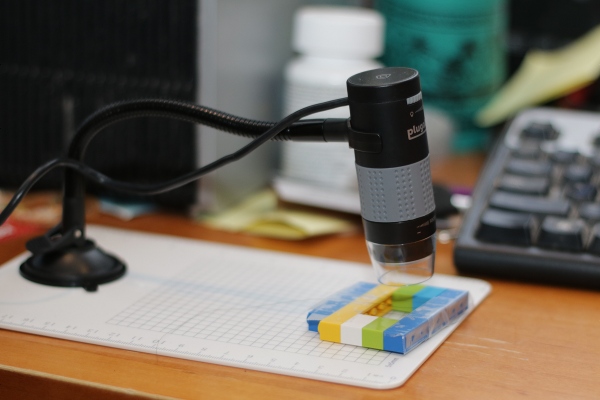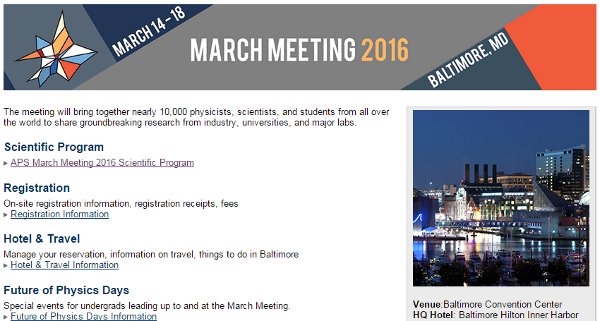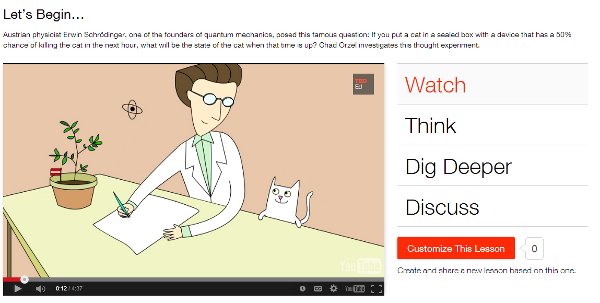It’s been a while since I last rounded up physics posts from Forbes, so there’s a good bunch of stuff on this list: — How Do Physicists Know What Electrons Are Doing Inside Matter?: An explanation of Angle-Resolved Photo-Electron Spectroscopy (ARPES), one of the major experimental techniques in condensed matter. I’m trying to figure out… Continue reading Physics Blogging Round-Up: ARPES, Optics, Band Gaps, Radiation Pressure, Home Science, and Catastrophe
Category: Condensed Matter
Physics Blogging Round-Up: Mostly March Meeting
I was at the APS March Meeting last week, because I needed tp give a talk reporting on the Schrödinger Sessions. But as long as I was going to be there anyway, I figured I should check out the huge range of talks on areas of physics that aren’t my normal thing– in fact, I… Continue reading Physics Blogging Round-Up: Mostly March Meeting
What Should I See At The March Meeting?
I’m going to be at the March Meeting of the American Physical Society in Baltimore next week. This is the largest physics meeting of the year, with an emphasis on condensed matter physics (which is actually the largest single area of study within physics, though media overemphasis on particle physics and astrophysics might lead you… Continue reading What Should I See At The March Meeting?
Tiny Forces, Artificial Materials, and Wobbling Stars: Physics Post Round-Up
I’ve been really busy with year-end wrap-up stuff, but have also posted a bunch of stuff at Forbes. which I’ve fallen down on my obligation to promote here… So, somewhat belatedly, here’s a collection of physics-y stuff that I’ve written recently: — Using Atoms To Measure Tiny Forces: A post reporting on some very cool… Continue reading Tiny Forces, Artificial Materials, and Wobbling Stars: Physics Post Round-Up
My Quantum Alarm Clock
One of the things I struggle with a bit when it comes to writing about cool modern physics is how much to play up the weirdness. On the one hand, people just can’t get enough of “spooky action at a distance,” but on the other hand, talking too much about that sort of thing makes… Continue reading My Quantum Alarm Clock
Diversity Is Frustrating: Cartoon Polygon Physics
Back in December, The Parable of the Polygons took social media by storm. It’s a simple little demonstration of how relatively small biases can lead to dramatic segregation effects, using cute cartoon polygons. You should go read it, if you haven’t already. I’ll wait. This post isn’t really about that. I mean, it is, but… Continue reading Diversity Is Frustrating: Cartoon Polygon Physics
PNAS: Asad Aboobaker, Thermal Engineer
I’ve decided to do a new round of profiles in the Project for Non-Academic Science (acronym deliberately chosen to coincide with a journal), as a way of getting a little more information out there to students studying in STEM fields who will likely end up with jobs off the “standard” academic science track. Sixth in… Continue reading PNAS: Asad Aboobaker, Thermal Engineer
Schrödinger’s Cat at TED-Ed
The third of the videos I wrote for TED-Ed is now live: Schrödinger’s Cat: A Thought Experiment in Quantum Mechanics.This is using basically the same argument I outlined in this post, but with awesome animation courtesy of Agota Vegso. I’m impressed by how close the images that ended up in the video are to the… Continue reading Schrödinger’s Cat at TED-Ed
Nobel Prize for Blue LEDs
The 2014 Nobel Prize in Physics has been awarded to Isamu Akasaki, Hiroshi Amano and Shuji Nakamura for the development of blue LED’s. As always, this is kind of fascinating to watch evolve in the social media sphere, because as a genuinely unexpected big science story, journalists don’t have pre-written articles based on an early… Continue reading Nobel Prize for Blue LEDs
On Black Magic in Physics
The latest in a long series of articles making me glad I don’t work in psychology was this piece about replication in the Guardian. This spins off some harsh criticism of replication studies and a call for an official policy requiring consultation with the original authors of a study that you’re attempting to replicate. The… Continue reading On Black Magic in Physics




